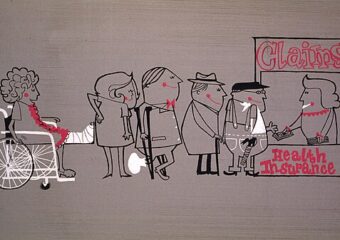The poet Micheal O’Siadhail (pronounced mee-hawl o’sheel) wrote a memoir of his late wife’s, Bríd’s, last two years with Parkinson’s disease. The memoir, One Crimson Thread, comprises 150 sonnets. All of them are affecting as they tell of the suffering Parkinson’s disease causes Bríd, the grief encroaching upon O’Siadhail, and the frustrations of ineffective and indifferent health care visited upon them both at various times. Mr P is fraying the crimson thread that has bound them together for forty-four years.
Among these sonnets of this time of suffering, confusion, fear, loneliness, loss, and grief, are some describing biomedical concepts in ways that extend the boundaries and depths of understanding beyond those typically available from classic biomedical sources. Four sonnets are selected here to illustrate how they work in this way.
The first sonnet describes a phase of Parkinson’s disease presenting as mental confusion, and the choice it foists upon family members and caregivers: should they go along with the delusions or correct them. O’Siadhail describes how this phase manifested in Bríd and his decision on how he should respond to it.
6
I find you talking to an absent friend Or nagged by some imagined bête noire, Yet loath to play along or condescend I have to be a human aide-memoire. Would it be sometimes kinder to let go, More gracious maybe not to gainsay you And settle for a neutral ‘Is that so?’ Respecting what for you must seem so true? Why should I undermine what’s undermined And take you from reality’s terrain? Now gently I explain there’s just us two; Your unseen guests are gremlins in the mind Suggesting you succumb to their domain. I can't yet yield and so give up on you.
O’Siadhail uses a sonnet form (“Wordsworthian”) in which the rhyming scheme changes between the first eight lines, in which the rhymes occur with every other line, and the last six lines, in which the rhymes occur with every third line. The change is meant to slow us down and to convey a more meditative component of his decision.
In the second selected sonnet, O’Siadhail describes what he often encounters when he enters a nursing home room where Bríd resides at the time. He also describes what he thinks Bríd must be feeling in a way that stops us in our tracks and gives us a view into how horrible it must be for her. O’Saidhail goes further into his own worries about being at fault and then to an analogy of losing her expressions of love to losing a limb and thus making him an amputee who suffers from a phantom limb, an analogy health care professionals can appreciate and thus apprehend his suffering at a level unachievable from typical biomedical presentations.
42
Good Friday afternoon I come and find You drooping in a corner on your own, A dozing migrant in your weary mind; I weep for you so weak and so alone. A silent scowl and deep inside I fear That anger always going on about How I’m to blame for your now being here; Your clouded thought begins to close me out. I am your love life’s grieving amputee Who says I love you as I always do; Though you no longer add ‘I love you too’, I stoop to steal a kiss that’s not for me. Bereft, I’m leaning on a phantom limb, My loneliness a ragged broken rhyme.
Note that this sonnet takes on a more conventional form (“Shakespearean”) of the first twelve lines across three quatrains with every other line rhyming, and then the last two lines which ordinary rhyme as a “rhyming couplet.” However, O’Siadhail breaks with that convention and is explicit about it by referring to “a ragged broken rhyme,” and in doing so further conveys how although he and Bríd were in contact, they were not in harmony.
The other two sonnets considered here refer to the challenge of getting the right balance of dopamine as part of Parkinson’s disease management. Dopamine and the drugs that act like dopamine have been used to treat Parkinson’s disease symptoms for many decades. They are effective, but they also require close management because the doses need to be high enough to ameliorate the motor problems of the disease, like tremors, slow movements, and rigidity, but not so high as to cause psychiatric problems like hallucinations, paranoia, and dementia. It’s a delicate balance and not always achieved.
But, what does this balance between the movement problems of Parkinson’s disease and the psychiatric side effects of dopamine look like as an illness experience? Can a poetic rendering add anything to a traditional biomedical description? O’Siadhail’s sonnets about Bríd’s Parkinson’s disease course suggest they most certainly can. Comparing these sonnets to a typical biomedical description of the balance needed in dopamine use makes their contribution more obvious.
A typical biomedical explanation of the balance needed is found in the 21st edition of Harrison’s Principles of Internal Medicine (2022):
Drugs used to treat PD can worsen cognitive function and should be stopped or reduced to try to provide a compromise between antiparkinsonian benefit and preserved cognitive function… Eventually, patients with cognitive impairment should be managed with the lowest dose of standard levodopa that provides meaningful antiparkinsonian effects and does not worsen mental function.
A slightly more straight forward biomedical explanation is found in the September – October, 2012 issue of Progress in Neurology and Psychiatry that provides the description of this balance starting with a scenario where a person with Parkinson’s disease presents psychotic symptoms from possibly too much dopamine (administered as levodopa or forms that mimic it), and suggests the following course of action:
…dopamine agonists should be reduced in dose or stopped, followed by a period of observation. However, improvement in psychotic symptoms may be accompanied by a deterioration in motor function, which may necessitate an increase in levodopa medication. The aim is to achieve an optimal balance between the treatment of motor and psychotic symptoms.
This biomedical explanations convey the problems related to the balance in broad clinical terms (e.g., “cognitive function,” “motor function,” “psychotic symptoms”). These explanations are good as far as it goes for being succinct and efficient. But they leave room for elaboration on how these clinical terms play out day after day for people with Parkinson’s disease and for those who are in their intimate spheres.
In the first of the two sonnets revolving around the dopamine treatment balance, O’Siadhail describes the terrorizing psychiatric effects of too much dopamine bathing the neurons in Bríd’s brain, the frustrating suspicions that her doctors don’t realize it’s the dopamine causing the problems, and the overwhelming relief he feels when Bríd’s psychosis relents.
81
Dementia? But you’re so sound of mind? I dare to think the doctors got it wrong; That dopamine and mimic drugs combined Misled their diagnosis all along. Those months confused, ignoring my concern, For no good reason you could cut up rough; I never thought then that you might return – My God how can I give you thanks enough? We never come to time, it comes to us. O moment when the mango kisses lime! Our every moment now a moment plus And this I’m telling you is double time. But even wishes wished our life outdares, This resurrection way beyond my prayers.
The second sonnet describes the consequences Bríd suffers as a result of pulling back on dopamine. Her movement problems reassert themselves, but she is free of the dopamine effect that had ravaged her mind. This sonnet makes clear that the balance sought between a clear mind and free movement is not always achievable, and that a tradeoff is forced when it is not. In the end, O’Siadhail is able to hold (and to have) a “still” Bríd.
83
I seem to celebrate on your account,
Today so rigid under my caress.
I kneel to kiss you now but no amount
Of love or care can lessen your distress.
Clear-mindedness but no more dopamine,
So you’re chair-bound, can barely move alone;
An unoiled body’s messaging machine
Shows all the drugs had blurred is now full-blown.
At least this deal allows the mind to mesh
And yet I know that you must pay the price;
Your Mr P. will have his pound of flesh
And this trade-off means such a sacrifice.
What can I do to settle suffering’s bill
Except to say, my Bríd, I hold you still?
These two sonnets add to our understanding of Parkinson’s disease at the level of neurotransmitter balances—dopamine doses in this case. The pharmacological explanations make the balance seem simple in conceptual terms. The clinical explanations make the balance seem achievable enough. O’Siadhail’s poetic explanation, however, renders in exquisite fashion the actual experience of this balance when it cannot be achieved, and when as a result, people living this predicament must make tradeoffs among only unfavorable choices.
These sonnets also show how the arts can be useful and important sources of knowledge and perspectives about how illness affects people in their daily lives that are generally not available in any expanded sense from biomedical sources, which rightfully focus on clinical elements of the disease. The other 144 sonnets add even more yet.
Source:
One Crimson Thread
Micheal O’Siadhail
Waco, Tx
Baylor University Press
2015
Notes:
Micheal O’Siadhail reads four of the sonnets and discusses them here on an episode of the podcast, The Clinic & The Person.
Photo from cover of One Crimson Thread.
The full breadth of Micheal O’Siadhail’s work can be seen at his website here.
A version of this post is on the NYU Literature, Arts and Medicine magazine site.



